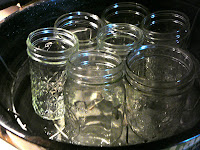 |
| The best part of home made grape jelly is the taste and smell as you sample it! |
Truth be told I have always intended to try this as I know full well my Grandmother's did not use any additives to be sure their jelly's set. So today after finding I have by my own estimate 12 cups of pure concord grape juice (a batch is usually 4 cups of juice) without having added a single drop of water, and only enough pectin for 2 batches, I elected to go the first batch the old fashioned way.
 |
| Deep, Dark, and Delicious Pure Grape Jelly. |
NOTE: THE JUICE WAS PREPARED FOR JELLY MAKING A DAY AHEAD AND THE INSTRUCTIONS ARE IN THE PREVIOUS POST.
If you would like the version using pectin here is the link, just click on to view that posting should you be interested.
thehiddenpantry.blogspot.com/2012/09/grape-jelly-old-fashioned-way-cooked.html
After opening the hanging cheese cloth bags the pulp just easily rolls out into the garbage. I stick the cheese cloth into a plastic bag and will launder it later for reusing. I just throw it in the washing machine on the smallest load setting and dry folded across a cloths hanger in the open air.
Next ready the bands and NEW seals by simmering them in boiling water. I set the clean jars above boiling water in the rack of the cold packer to keep them hot. I am all about getting everything ready BEFORE I start!
According to the Ball Blue Book there are 2 ways to go about this, one is cooking until the jelly will sheet or slide off of a plate or spoon or the temperature method which is the way I prefer to go as it seems like a bit less guess work to me! But it involves an extra step. You must first check to see what the exact temperature at which water begins to boil where you are.
Place about 2 1/2" tap water in a clean saucepan and watch it as you bring it to a boil. Do not let the thermometer touch the bottom of the pan. At the time the water begins to bubble in a full boil record the temperature. Here it was 212 degrees F. Next add 8 degrees. This is the jell temperature for this jelly. Here it was 220 degrees F.
 |
| Straining a second times removes any crystals that may have formed. |
I choose to strain the juice again into a gallon pitcher. This time I strained through 4 layers of cheesecloth and placed it inside a large strainer for support at the top of my pitcher removing any crystals that might have formed.
Ingredients for Grape Jelly:
4 C. prepared grape juice
3 C. sugar
optional 1 t. butter
Place the juice prepared as in the previous post into a large heavy bottomed kettle and add the sugar over high heat stirring until the sugar is dissolved. You may choose to add 1 teaspoon of butter if desired to prevent or reduce the amount of foam that will form during this cooking process. This is optional, I do add the butter.
Cook and stir constantly until you reach the jell temperature as explained above. I made sure it was about 1/2 a degree more just to be sure I was looking at the thermometer at the correct angle!
Immediately remove from the heat. Skim off any foam. Fill the hot jars to within 1/4" of the top of the jar and cap and band them snugly.
I had earlier called my sister Linda who is also a jelly maker to confer because we have always at this point turned the jars upside down and left them undisturbed for exactly 10 minutes then turned them upright. The jars have then always sealed and we leave them alone then for 2 weeks as sometimes it can take that long for the jelly to set. THIS IS EVIDENTLY NO LONGER THE PRESCRIBED METHOD. But it is the way we have always done it.
The Ball Blue Book directs you too process the jars in the water bath covered with 1-2" of water for 10 minutes before removing and cooling the jelly. Then again leave undisturbed for 2 weeks to be sure it had set.
If your jelly does not set you can reprocess it in some instances. I recommend the Ball Blue Book in that situation.
 |
| I think Grandma would be proud! |
This recipe made about 5 cups of jelly and I took the little bit I had left and used a juice jar. I stuck it in the refrigerator for a few minutes and it hardened right away so I am pretty confident it is fine!
I hear the lids popping to seal from here! I tasted the little bit I had skimmed and it was delicious!
Today's final tally is 22 1/2 cups of grape jelly. The first batch was 4 C. juice + 3 C. sugar = 5 cups jelly. I used my 2 packages of pectin for the next 2 batches, each batch used 4 C. juice = 6 3/4 C. sugar = 17 1/2 C. jelly or a little over 8 cups per batch.
Funny thing I had maybe 2 tablespoons of juice left over! Makes me happy, happy, happy and pooped!

























































